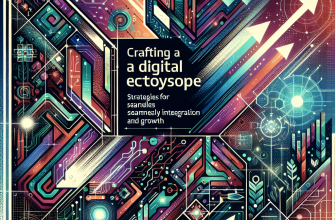- Exploring the Key Components of a Digital Ecosystem: Connectivity, Platforms, Data, and User Experience
- Connectivity: The Lifeline of Digital Operations
- Platforms: The Stages on Which Digital Strategies Unfold
- Data: The Fuel for Strategic Insights
- User Experience (UX): The Heart of Customer Engagement
- Integrating the Components for Digital Success
Exploring the Key Components of a Digital Ecosystem: Connectivity, Platforms, Data, and User Experience
In today’s rapidly evolving digital landscape, understanding the intricate web of a digital ecosystem is crucial for any business aiming to thrive. As a digital marketing expert, I’ve seen firsthand how mastering the components of connectivity, platforms, data, and user experience can transform a company’s online presence. Let’s dive deep into each of these pillars and explore how they interconnect to drive digital success.
Connectivity: The Lifeline of Digital Operations
Connectivity is the backbone of any digital ecosystem. It’s not just about having internet access; it’s about how effectively your business is connected to its stakeholders through various digital channels. This includes everything from mobile networks and cloud computing to IoT (Internet of Things) integrations and beyond.
In the realm of digital marketing, connectivity ensures that your campaigns reach their intended audiences without a hitch. It also facilitates real-time data flow and communication, which are critical for timely decision-making and customer service. As 5G technology becomes more widespread, the potential for enhanced connectivity that is faster and more reliable will open new avenues for innovative marketing strategies and improved customer interactions.
Platforms: The Stages on Which Digital Strategies Unfold
Platforms in a digital ecosystem refer to the software and technology frameworks that businesses use to engage with customers, manage operations, and deliver services. These can range from social media networks and e-commerce websites to CRM systems and marketing automation tools.
Choosing the right platforms is pivotal because they determine how well you can implement your digital strategies. For instance, an e-commerce business might rely heavily on Shopify or Magento, while a service-oriented company might focus on Salesforce or HubSpot to manage client interactions. Each platform comes with its strengths and limitations, and the key is to select those that best align with your business goals and customer needs.
Data: The Fuel for Strategic Insights
Data is undoubtedly one of the most critical components of a digital ecosystem. It provides the insights necessary to understand market trends, customer behavior, and the overall performance of your digital marketing efforts. However, the challenge lies not just in collecting data, but in analyzing and utilizing it effectively to make informed decisions.
Effective data management involves setting up proper analytics tools, ensuring data quality, and maintaining privacy and security standards. Tools like Google Analytics, Adobe Analytics, and various AI-powered analytics platforms can help parse through vast amounts of data to deliver actionable insights. These insights allow marketers to refine their strategies, personalize customer interactions, and optimize ROI.
User Experience (UX): The Heart of Customer Engagement
Lastly, user experience (UX) is the element that can make or break your digital ecosystem. UX encompasses all aspects of the end-user’s interaction with your company, its services, and its products. The goal is to create easy, efficient, satisfying, and all-around pleasant experiences for users.
A stellar UX requires a deep understanding of your users’ needs, behaviors, and pain points. This understanding should then be translated into website design, app functionality, content, and customer service. For example, a simple, intuitive website navigation can significantly enhance the user experience, thereby increasing the likelihood of conversion and customer retention.
UX also ties closely with other components like data and platforms. For instance, user feedback can be gathered and analyzed to drive UX improvements, and the choice of platform can affect how well you can tailor the UX to meet your users’ expectations.
Integrating the Components for Digital Success
The true power of a digital ecosystem lies in how well these components—connectivity, platforms, data, and UX—are integrated. A disjointed approach can lead to inefficiencies and a fragmented user experience. However, when these elements are aligned and synergized, they create a robust digital ecosystem that can adapt to changes in the market and consumer behavior, drive engagement, and foster business growth.
In conclusion, as businesses continue to navigate the digital domain, understanding and optimizing the key components of their digital ecosystem is essential. Connectivity ensures that your digital touchpoints are reliable and wide-reaching, platforms provide the necessary tools to engage and manage customer interactions, data offers the insights needed to make strategic decisions, and UX ensures that customer interactions are positive and fulfilling. Together, these components form the foundation of a successful digital strategy in the digital age.

A seasoned digital marketing strategist with over 8 years of experience across various areas of digital marketing, including SEO, SMM, PPC, content marketing, and email marketing. Specializes in transforming B2B, B2C, e-commerce, and SaaS businesses by creating effective go-to-market strategies and building thriving digital ecosystems. Known for a data-driven approach to optimizing campaigns and maximizing results.
“If your business is looking to scale or in need of a fresh perspective, feel free to contact”.





